Jose Altuve, Dustin Pedroia, and Divergent Roads
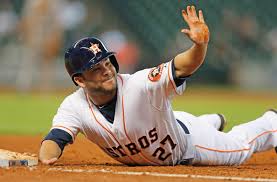
Houston Astros second baseman Jose Altuve just had a very impressive ALCS, during which he hit .313/.353/.688, with three homers and nine runs scored in seven games. His team lost, but his performances added another item to his accomplished postseason resume. He’s now played in 103 post-season games, ranking seventh all-time, and his name is all-over the career postseason leaderboard (courtesy FanGraphs):
- Games—103 (7th)
- Plate Appearances—476 (5th)
- Hits—117 (4th)
- Doubles—21 (5th)
- Home Runs—27 (2nd)
- Runs—89 (2nd)
- RBI—55 (7th)
During the series, there was talk about Altuve’s future Hall of Fame possibilities. He just completed his age-33 season and was as good as ever despite missing almost half the season with injuries. His 154 wRC+ was the third-highest of his career and this came after last year’s 164 wRC+, which was the highest of his career (wRC+ is a metric that adjusts for league and ballpark effects where 100 is league average; a 154 wRC+ means Altuve was 54% better than league average on offense in 2023). Altuve is essentially having a second peak, like a two-humped Bactrian camel as opposed to the typical one-humped dromedary.
Altuve seemed to top out as a hitter back in 2016 and 2017 (152 wRC+ and 160 wRC+) when he was at the typical peak ages of 26 and 27 years old. As he hit his late 20s and early 30s, his wRC+ dropped into the 130-range, with the truly awful 2020 COVID season being a major outlier (74 wRC+). Now he’s back where he was six years ago and you have to wonder what the future brings.
Jose Altuve is famously a small person, especially compared to his fellow professional baseball players. There’s an iconic image of Altuve standing next to an incredibly large person, Aaron Judge, that boggles the mind. How can two players so different in size both be so good at the same sport? When you see the picture of them standing side by side, you might think Altuve is a thoroughbred racehorse jockey and Judge is an NFL tight end.
Aaron Judge is listed at six-foot-seven and 282 pounds, while Altuve is officially listed at five-foot-six and 166 pounds. That height is very doubtful, to say the least. I don’t think anyone actually believes that Altuve is five-foot-six, but that’s his “official” height.
Five years before Altuve reached the major leagues, another diminutive second baseman made his debut. Dustin “Pee Wee” Pedroia came up with the Boston Red Sox as a 22-year-old in 2006. He’s listed at five-foot-nine and 175 pounds, which is just as doubtful as Altuve’s listed height and weight. They played the same position, second base, and hit homers, stole bases, and sparked their teams to postseason success.
Pedroia was a key part of a Red Sox team that made the playoffs eight times in his 14 years, which included three World Series titles. Altuve has played on eight playoff teams in his 13 years with Houston and has two World Series titles. Pedroia was the 2007 AL Rookie of the Year and 2008 AL MVP. He made the All-Star team four times. Altuve doesn’t have a Rookie of the Year award, but did win the 2017 AL MVP award and has been an All-Star eight times.
Both players approached home run hitting the same way—grip it and rip it to left field. That’s where their power was and is. The spray charts below show the home runs hit by Altuve and Pedroia in their careers. The vast majority of their dingers landed in the left field seats, with many of Altuve’s finding a home in the Crawford Boxes and many of Pedroia’s flying over the Green Monster.
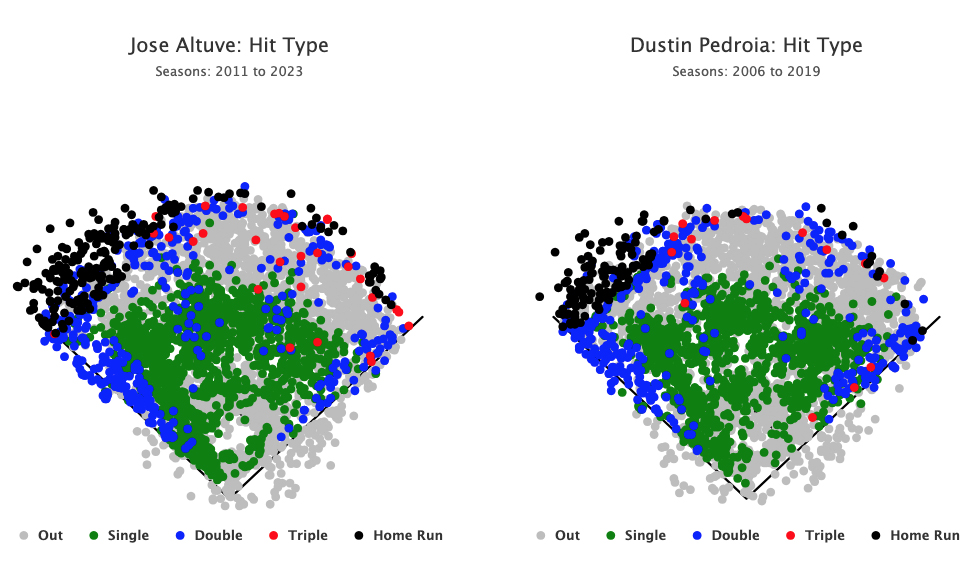
Pedroia was confident. Some might say cocky. He had a swagger about him whenever he took the field. He gave us the phrase “Laser Show.” He was loved by Red Sox fans and his teammates, even those who played with him for nine seasons and still didn’t know his real first name. Opposing fans may have hated him, but they had to respect him.
Altuve doesn’t have the big personality that Pedroia had, but when a guy his size establishes himself in the big leagues as a light-hitting, base-stealing second baseman, then bangs out four straight 200-hit seasons and steals 39 bases per year while hitting .334/.384/.496 and morphing into a 20-plus home run hitter, which Altuve did from 2014-2017, fans all across baseball couldn’t help but root for him.
Of course, then came the revelation of the Houston Astros cheating scandal and that all changed for Altuve. Now he and Alex Bregman, the last remaining Astros from the 2017 team, are among the most-booed players in baseball when playing on the road. That’s a story for another day, but it should be noted that the data analyzed at the Sign Stealing Scandal website shows Altuve was a minimal participant.
As for Pedroia, he retired as a much-loved player whose career ended too soon because of injuries. The charts below show the two player’s careers lined up by age. They both established themselves as above-average players at the age of 23, then had their first great years at age 24. That was Pedroia’s MVP year when his good hitting and impressive defense led to a 6.4-WAR season, the second-best of his career. Altuve’s age-24 season was his first well above average offensive year, with a 137 wRC+, and a league-leading 56 stolen bases.
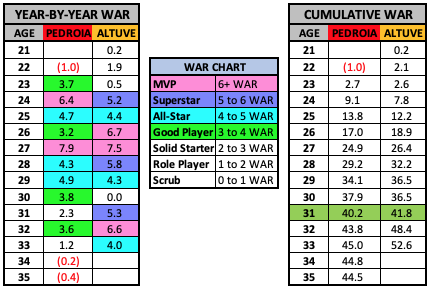
After their big age-24 seasons, both Pedroia and Altuve reeled off good-to-great seasons for the rest of their 20s. They were both particularly good at age 27, when Pedroia had a career-high 7.9 WAR and Altuve had a career-high 7.5 WAR (his MVP year). Altuve had the anomaly of a season in the 2020 COVID year at age 30 before bouncing back with a vengeance, while Pedroia started to wind down a bit as he hit his 30s. He had his last good year at age 32, then played in just 105 games at age 33, before injuries really took their toll and he hardly played at all at ages 34 and 35.
I’ve highlighted the age-31 years for Pedroia and Altuve in green on the chart on the above right. At that point, they weren’t far apart in career WAR, with just a 1.6-WAR advantage for Altuve. The chart below show where they ranked among all second basemen in baseball history through their age-31 seasons:
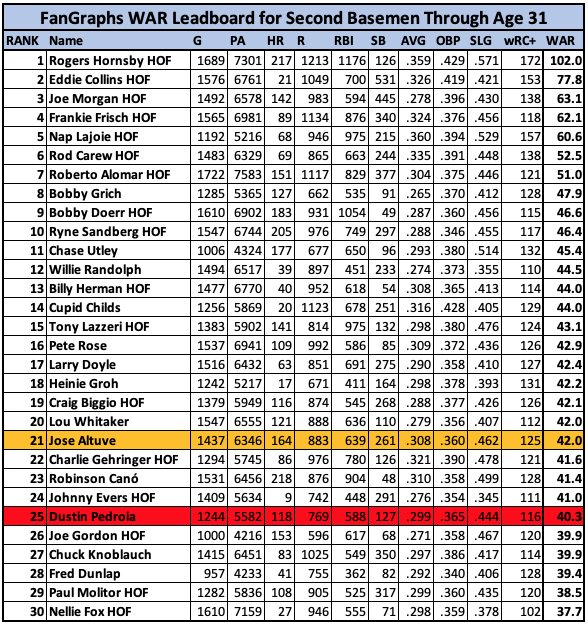
Mixed in and around Altuve (21st) and Pedroia (25th) were some future Hall of Fame second basemen, including some players from well in the past along with two from the last 50 years—Paul Molitor (29th) and Craig Biggio (19th).
Pedroia was a good player again at age 32 when he played in 154 games, had 698 plate appearances, and hit .318/.376/.449 (121 wRC+). The end came quickly, though, starting with the 2017 season, when he was 33 years old. His first stint on the Injured List came at the end of May, but it was only a sprained left wrist and he returned after just 10 days. On August 1, he was put on the IL with left knee inflammation. He tried to get back on the field not long after, but was placed back on the IL on August 12. He returned in September to play 19 games, but struggled at the plate, hitting .242/.320/.318 (70 wRC+).
After the 2017 season, Pedroia had cartilage restoration surgery on his left knee, which caused him to miss the first seven weeks of the 2018 season. He was activated from the IL on May 25, but right back on it on June 2 after playing in just three games. He never returned that season as the Red Sox cruised to 108 wins and a World Series title. It was a similar story in 2019. He had another surgery on the knee in the offseason which caused him to start the year on the IL. Through multiple IL stints, he played in just six games in what would be his final year on the field. His 44.5 career WAR ranks 30th all-time among second baseman, one spot behind Hall of Famer Nellie Fox.
While Pedroia’s career took a downward turn in his early-30s and was essentially over after his age-33 season, Altuve just had a 4-WAR season despite missing the first six weeks while recovering from surgery to repair his fractured right thumb courtesy of a hit-by-pitch in the World Baseball Classic. He later had discomfort in his left oblique that caused him to miss another 20 days. He was top-notch when on the field, though, and has moved up considerably on the all-time WAR list for second basemen. The following chart shows the WAR leaders at second base through the age of 33.
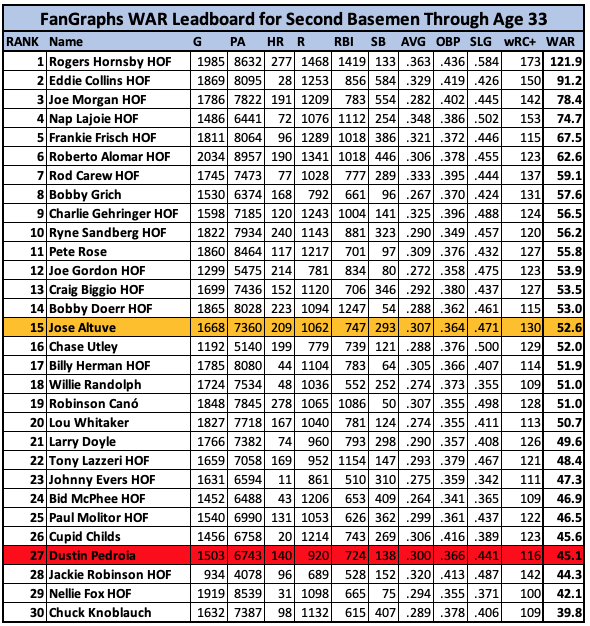
When their age 32 and 33 seasons are added to the mix, Pedroia drops a couple spots on the leaderboard through age-33, while Altuve shoots up to 15th, right on the heels of three Hall of Famers.
On the overall career WAR leaderboard for second basemen, Altuve ranks 22nd, right between Hall of Famers Bobby Doerr and Tony Lazzeri. With another good season in 2023 under his belt, and his postseason success, he continues to build his case for the Baseball Hall of Fame.
A back-of-the-envelope method of forecasting future WAR was created by Tom Tango with this post at his blog. If I followed his method correctly, the very rudimentary forecast for Jose Altuve’s remaining years would be WARs of 3.5, 2.7, 2.1, 1.5, 0.9, then he would be near replacement-level at age 39. That adds up to 10.7 WAR which, when combined with his current 52.6 WAR, would give him 63.3 for his career. That would place him 12th all-time, just behind Roberto Alomar (63.6 WAR).
Another quick-and-easy way to consider what Altuve might do in the future is shown below. I used the five second basemen directly above and the five directly below Altuve on the chart from earlier and added their career WAR to find the WAR they contributed after age 33. The average for these 10 players was 9.6 WAR after age 33. The median was 8.4. If you split the difference and give Altuve nine additional WAR, he would finish his career with 61.6, which would rank 14th, tied with Chase Utley and slightly ahead of Hall of Famers Ryne Sandberg and Joe Gordon.
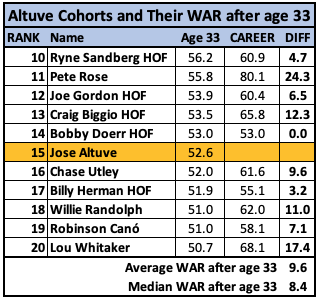
Dustin Pedroia and Jose Altuve were near equals in career value through age 31 before their roads started to diverge. At the time, they both had Hall of Fame potential. Injuries have ended that dream for Pedroia, while Altuve continues his journey to the stage at Cooperstown, where he hopes the cheers of Astros fans will drown out whatever boos may come his way.
-Bobby Mueller












